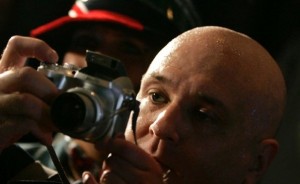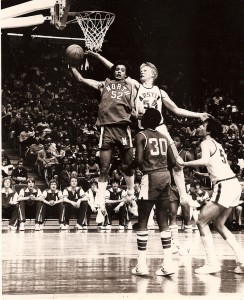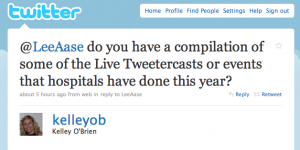Author: Lee Aase
Social Media 401: Vince Muzik Case Study

I’ve known Vince Muzik for nearly four decades, ever since I took piano lessons from his mother, Jan. (Yes, my piano teacher was Mrs. Muzik.) But it gets even better: Vince’s father, Conrad, was the Austin High School band instructor, so when I played trombone (until 9th grade) my instructor was… Mr. Muzik.
Vince’s love was photography, though, and particularly relating to sports. He got his first chance to shoot a big statewide event when he was a teenager, and the Austin Daily Herald got him press credentials for our basketball team’s trip to the state high basketball tournament in 1981. We were 22-0 going into the tournament, but faced the also-unbeaten (and defending champion) Minneapolis North in the first round. Here’s a photo Vince took at that game (can you tell which one is me?)

Although I didn’t get that rebound, we did come back to win the game after being down 31-24 at halftime. We beat another undefeated team, Chaska, in the semifinals, before losing to Anoka in the championship game. Here’s my admittedly self-serving highlight video from that experience, which is only available thanks to another friend whose brother was one of the few consumers who had a VCR at the time:
Vince has stayed interested in sports, and has gotten opportunities to shoot some much bigger events with much better athletes. We reconnected this year when he heard about what I was doing in social media at Mayo Clinic and about SMUG, and he asked me for advice about a really exciting project he had in mind. Now that he’s getting it off the ground, I want to highlight it as a great example of using social media tools to tell a story.
Vince lives in the Twin Cities now, and has made some good connections with Cretin-Derham Hall, where American League MVP Joe Mauer of the Minnesota Twins went to high school. Other notable alums include hall-of-famer Paul Molitor, 2000 Heisman Trophy winner Chris Weinke, Baltimore Ravens All-Pro Center Matt Birk and current Notre Dame star receiver Michael Floyd.
This year, CDH has the consensus number one football recruit in the nation, Seantrel Henderson, and Vince’s great idea was to tell the story of what it’s like to be that guy, giving a behind-the-scenes look at the recruiting process.
Vince is a great storyteller, but his niche has been photography. And sometimes a niche can become a pigeonhole. But with social media, he can break out of that niche. He’s getting video of Seantrel talking about his experiences, and sending a Flip video camera with his parents as they go along on official visits. Here’s the video Vince posted of Seantrel’s Ohio State visit and his conversation with former Buckeye Chris Carter and with coach Jim Tressel:
This video has already been picked up by the Cleveland Plain Dealer, and SportsIllustrated.com also asked Vince to send it to be embedded there.
I don’t know where this will end up, and neither does Vince, but one thing it shows is how the low cost and easy availability of social media tools make it possible for someone with a good idea to just make it happen instead of needing to pitch it in advance to a mainstream media outlet. As he says:
I suppose you could say this is part of a social media documentary project I’m doing on Seantrel about recruiting and his life as the No. 1 recruit in the country. If it works out, someday you’ll be able to download it and watch it on your computer or iPhone or Blackberry. Or I may just keep following him until he gets to the NFL. We’ll see.
When he was a teenager back in Austin, Vince had to get the local newspaper to bless his photography project before he could do it. Now he is using YouTube, Twitter (@VMuzikman) and a WordPress.com blog as his publishing platform, with a Flip camera as his main video source. His first video is up to about 12,000 views as of this writing.
Vince is a star SMUGgle who is putting the MacGyver mindset into action.
I hope you will follow what he’s doing and help spread the word about his #Seantrel project, and if you have suggestions for how he can improve, give him feedback.
More than that, I hope you will follow his example and just dive in and start using social media tools creatively in your projects.
Exploring Facebook Connect
I decided to explore adding Facebook Connect functionality to SMUG on Friday night.
I know what you’re thinking: “So that’s how you spend your Friday nights?”
At any rate, I just wanted to explain some clunky looking interface issues that you may see for a day or so while I figure this out.
Please bear with me. After I get the bugs worked out I will share how I did it.
Meanwhile, I appreciate Nick Dawson’s encouragement to try this. He said he’s using the WP-Facebook Connect plug-in in version 2.8.x of WordPress, even though the directory says it’s only compatible through version 2.6.
[ratings]
Out of Gas
I had an interesting adventure about this time yesterday as I drove from Austin to Bloomington, Minn. for the ICSI seminar, at which I was scheduled to present. Thankfully, I wasn’t even really late, but it wasn’t because of any merit or planning on my part. If had run out of gas 15 seconds later, it would have been a much more difficult situation.
Here are some highlights, from about 7:55 to 8:10 on Wednesday:
Let this be a lesson to you!
[ratings]
Hospital Twitter Chat List
[ratings]
Kelley O’Brien (@kelleyob) from North Carolina posed the following question via a tweet this afternoon:
A. I’m not aware of anything like a comprehensive list of hospital Twitter chats. Ed Bennett’s Hospital Social Networking List is a great resource to tell us which hospitals have social media presence, and he even has some great hospital Twitter lists by state, but the list doesn’t include specific projects (such as surgical cases being “tweeted” that have been undertaken by hospitals or healthcare organizations.
But the great thing about social media is that you can build a list pretty quickly by crowdsourcing…via Twitter.
Or at least I think we can. Let’s see!
I’m listing below some of the Twitter chats/events I’ve been involved with through Mayo Clinic, along with some others I’m aware of that others have done.
It’s not even close to exhaustive. But that’s where you come in. If you know of hospitals that have done Twitter events, whether it was related to a surgical procedure, or a communications crisis, or promoting research findings, or whatever other ways you’ve used Twitter (or seen it used) in a hospital setting, please tell about it in the comments below.
Please include the name of the hospital, its Twitter handle, a relevant link to a post, news release or news story describing the effort, and any description you would like to add. Also please indicate which category (listed in bold below) is appropriate. And if you think I’m missing a category that should be added, please tell me that, too.
You also can share your examples via Twitter, using the #HospitalTweets tag. But by adding them in the comments below, they’ll be more permanent (since Twitter doesn’t archive tweets)…and of course, you’re not limited to 140 characters.
I will update this post based on your contributions to create a more comprehensive list.
Let’s see how quickly we can come up with a really good list!
Surgical Case Tweeting
- Henry Ford Health System (@HenryFordNews) and Bill Ferris (@Billfer) were, I believe, the first to do a live-tweeting exercise from the operating room.
- Aurora Health Care (@Aurora_Health) in Wisconsin got significant media attention for tweeting a knee operation.
- HealthOne Presbyterian/St. Luke’s in Denver collaborated with a local TV station on a Twitter procedure, as @angieanania describes.
- Sherman Hospital (@ShermanHealth) did the first live tweeting in Illinois.
Research Communications
- We did a @mayoclinic Twitter chat with @vmontori about a scientific journal article on diabetes and blood-sugar control.
Crisis Communications
- Innovis Health (@InnovisHealth) used Twitter to provide real-time updates during Fargo’s floods in March.
- Scott & White Healthcare (@SWHealthCare) used social media to manage the crisis surrounding the Fort Hood shootings and the victims who had been transported there for care.
Presentations and Training:
- At @MayoClinic, we have held three Tweetcamps to provide training for staff. Here’s a post that describes Tweetcamp III.
- When I do presentations, I regularly include a Twitter back-channel, such as this training seminar on social media I did yesterday with local advocacy chapters of American Heart Association. This is a good way for participants to get hands-on experience with Twitter.
Mainstream Media Collaboration
- @MayoClinic has done Twitter chats with @USAToday and @BrophyMarcUSAT related to this article about an under-diagnosed type of wrist pain that afflicted Philadelphia Phillies Outfielder Jayson Werth, and also about H1N1 flu and kids with asthma, as well as another relating to obsessive-compulsive disorder (OCD) and phobias.
- See the Denver example above in the Surgical Case Tweeting category.
What other examples can you add?
